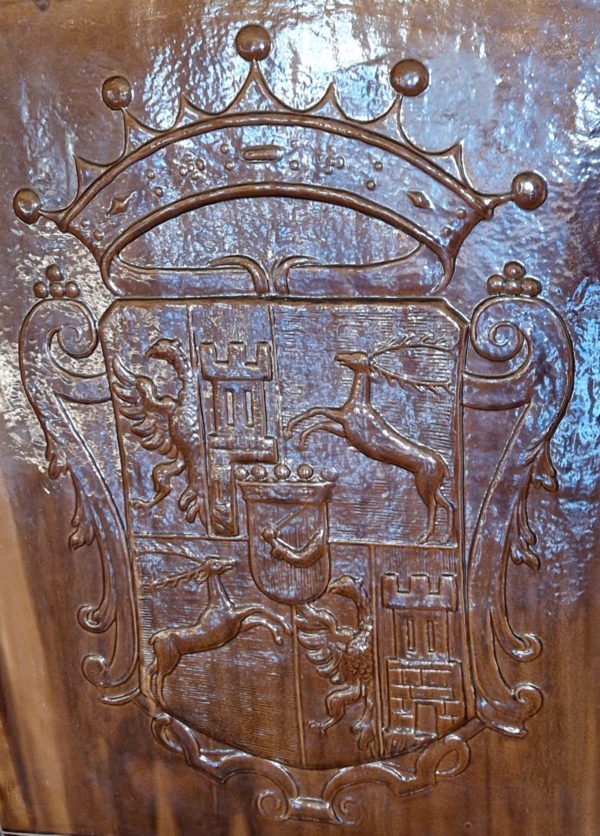
Coat of arms of the Barons Janežič-Adlersheim in Jablje Castle
LOKA PRI MENGšU, JABLJE CASTLE
Location of the coat of arms: decorative object
In the mid-eighteenth century, Jabl(j)e Castle (Habach) was in the hands of Baron Anton Josef von Janeschitz (Slovenianized: Janežič). Its owner for a little more than four decades, Janeschitz left a profound and still visible mark on the castle building. Embarking on its thorough renovation, he commissioned paintings with mythological and romantic scenes from Franc Jelovšek. Among the furnishings dating to his time are also stoves graced by his baronial coat of arms, distinguished from the basic design in the heart-shaped inescutcheon featuring a hand with a saber as well as in the baronial five-pointed coronet above the main escutcheon and the heart-shaped inescutcheon.
The beginnings of the Janeschitz family’s noble status reach back to the early eighteenth century and the Jable castellan’s grandfather. In November 1716, Emperor Charles VI granted the rank of nobility to the mayor of Ljubljana and former successful merchant Johann Anton Janeschitz. Johann Anton, who could thenceforth sign himself as von Janeschitz, was also granted the predicate Adlersheim, adding more luster to his Slovenian surname.
His unhappy marriage to Maria Jacobina de Giorgio produced six children, of which only his son Franz Anton survived to adulthood; however, dying at age thirty, he too was ultimately outlived by his father. Therefore, Johann Anton bequeathed his estate to his daughter-in-law Anna Margareta (who later married Baron von Lichtenberg) and his only grandson Josef Anton. On his grandfather’s death in 1730, the eight-year-old Josef Anton also came into an enormous wealth.
Pursuing a less-than-virtuous private life, Josef Anton von Janeschitz did not leave the best impression on his contemporaries. Part of the blame for his immoral disposition perhaps lies in the fact that he grew up as a wealthy heir without his father’s firm hand. He showed ambition from very early on. Thus, immediately after coming of age in 1743 and assuming control over the vast family property, he purchased Jable Castle. On this basis he first requested to be admitted to the Carniolan provincial estates and later that year also to be granted the baronial title.
His marriage to an “orphaned young lady from Silesia,” Franziska Countess von Hofmann, was an unhappy one. The newly made baron apparently had a quick temper, and he frequently attended parties without the company of his wife, who soon began to develop feelings for Johann Seyfried Count von Herberstein, the president of the Representation and Chamber for Carniola (provincial government). After this came to his knowledge, Josef Anton physically assaulted his wife and was taken to court for it. Although he was acquitted of all charges, their marriage did not last much longer; his wife was ultimately granted a divorce and moved out of Carniola.
This left Josef Anton as the first and the last Baron von Janeschitz. After his failed marriage produced no children, he stipulated in his will in 1777 that his entire estate pass on to the older of his half-brothers, Franz Xaver Baron von Lichtenberg—however, under the condition that the main heir assume the family name Janeschitz and its baronial coat of arms. Josef Anton Baron von Janeschitz died three years later, on Candlemas 1780. His heir, Franz Xaver, heeded his half-brother’s last wish and requested that the imperial court formally unify his family name and coat of arms with those of the Janeschitz family. His request was granted by the new Emperor Joseph II in January 1781. Thenceforth the Barons Lichtenberg officially assumed the name Barons Lichtenberg-Janeschitz and used the marshalled Lichtenberg-Janeschitz coat of arms.
Sources:
Preinfalk, Miha: Plemiške rodbine na Slovenskem, 18. stoletje; 2. del: Od Del-Negrov do Škerpinov. Ljubljana: Viharnik, 2022, str. 65-74.
